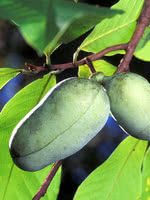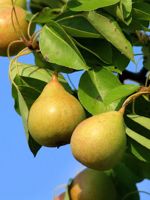Mon-Fri 9am - 5pm Mountain time
Pawpaw vs Loving Pear
Asimina triloba
Pyrus Loving
COMING SOON
(new stock expected: later this season)
The Pawpaw tree produces delicious, sweet fruit with a unique banana-mango flavor. These oblong fruits start yellowish-green and mature to a dark brown in the fall. It is best to leave them on the tree until ripe, as they do not ripen well once picked. Pawpaws can be enjoyed fresh, in baking, or in ice cream.
Pawpaws produce the largest native fruit in North America. They typically grow as a small understory tree or large shrub on wooded slopes, in ravines, and along stream banks. They often spread through root suckers, forming dense thickets over time.
For fruit production to occur more than one genetically different Pawpaw tree is required. Our Pawpaw seedlings are grown from seed so they are all genetically different.
Note: Avoid eating the seeds and skin of the Pawpaw fruit as they can cause stomach pain for some individuals. Contact with the skin of the fruit can also result in skin irritation, so it is recommended to wear gloves during harvest. Plant this tree once. Due to its large tap root transplanting is not recommended.
Loving Pear is a Russian pear variety with a mild sweet flavor and a hint of sour. It is known for being cold hardy and disease resistant. They are green in colour but will transition to have a slightly golden red blush when ripe. With a minimal neck, they have a more rounded appearance.
They ripen in early September. It is recommended that they are harvested as the seeds begin to brown. They can finish ripening after picking. They keep well in cold storage and are suited for fresh eating, juicing, and dehydrating.
The Loving Pear requires a second variety for cross pollination. Some compatible varieties include Krazulya, Golden Spice, and others.

